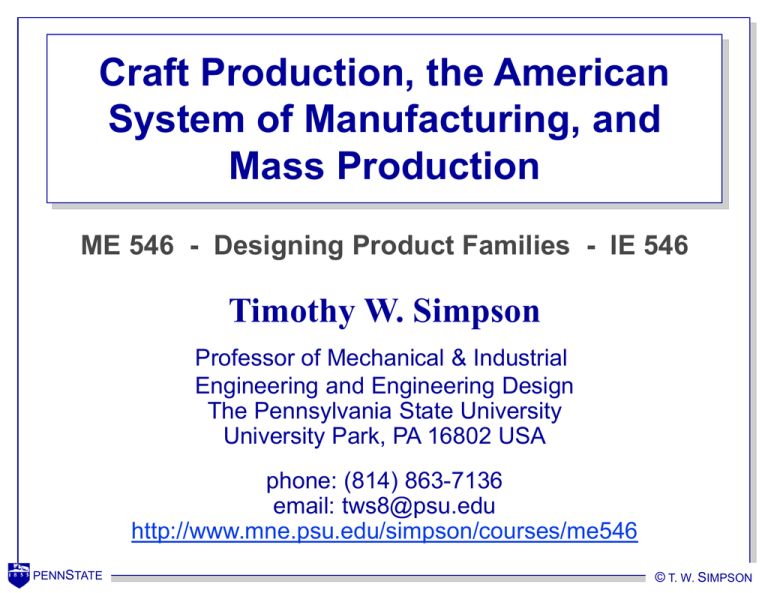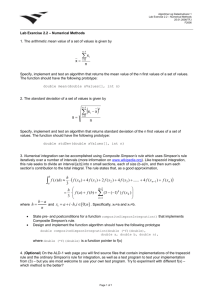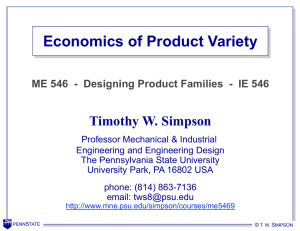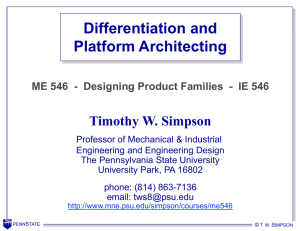PPT - Department of Mechanical and Nuclear Engineering
advertisement

Craft Production, the American System of Manufacturing, and Mass Production ME 546 - Designing Product Families - IE 546 Timothy W. Simpson Professor of Mechanical & Industrial Engineering and Engineering Design The Pennsylvania State University University Park, PA 16802 USA phone: (814) 863-7136 email: tws8@psu.edu http://www.mne.psu.edu/simpson/courses/me546 PENNSTATE © T. T. W. W. S SIMPSON IMPSON Overview of Today’s Class • Motivating Vignette Excerpt from J.B. Pine II, Mass Customization, Harvard Business School Press, Boston, MA, 1993, pp. 3-5. • What is Craft Production? The “Skill” and the “Art” of Craft Production • Craft Production Firms of Today A visit to Aston Martin’s web site • The American System of Manufacturing Principles of the American System of Manufacturing • Introduction to Mass Production Principles of the Mass Production PENNSTATE © T. W. SIMPSON What is Craft Production? • Craft production is characterized by: Highly skilled work force; knowledge of design, machining, and fitting learned through apprenticeship. Artisans with the skills and know-how to turn raw materials into finished goods; not only an art, but a source of pride. Decentralized organizations where owner is in direct contact with everyone—customers, employers, and suppliers. General-purpose machine tools to drill, grind, cut, etc., wood and metal. Lack of economies of scale: cost to make 200,000 cars only slightly less than cost to make 10 cars. Very low production volume: 1000 or fewer automobiles a year; maybe 50 of the same design, but no two exactly alike because of fitting process. PENNSTATE © T. W. SIMPSON Why the Fitting Problems? • In the 1890s: Contractors did not use standard gauging systems. Machine tools could not cut hardened steel. • Contractors used slightly different gauges and ran parts through an oven to harden the surfaces. • Parts frequently warped in the oven and needed further machining to regain original shape. • Dimensions where “approximate”: Parts had to be filed until they fit together. Start with two parts, file and add third, etc, until the whole vehicle was complete. PENNSTATE © T. W. SIMPSON The End Result... • “Dimensional Creep” No two cars were ever the same since the dimensions varied from one car to the next even though manufactured from the same blueprints. • However… Manufacturers catered to the rich who had chauffeurs and mechanics to drive and fix the cars. Cost, driving ease, and simple maintenance were not primary concerns; only speed and customization (e.g., special body or styling). PENNSTATE © T. W. SIMPSON Craft Production Firms Today • There are some craft production firms still operating. Focus on tiny niches, usually upper, luxury end of market. Buyers who want a unique image and opportunity to deal directly with factory. Make agreements with larger firms to gain specialized expertise in areas of technological development. • Do you know any successful craft production firms? PENNSTATE © T. W. SIMPSON Example: Aston Martin http://www.astonmartin.com/ • Aston Martin has made 14,000 cars over the past 80 years. • They average 1 automobile per day. • Skilled panel beaters make the aluminum body panels by pounding sheets of aluminum with wooden mallets. “Aston Martin promises owners an exclusive, exhilarating adventure in an individually produced, true British sports car.” Aston Martin V8 Volante PENNSTATE Aston Martin V8 Le Mans Vantage © T. W. SIMPSON Aston Martin: The Company • The following are excerpts from http://www.astonmartin.com/ “Founded in 1914 by Lionel Martin and Robert Bamford in a small West London workshop, Aston Martin has grown over more than 80 years to become a world-renowned manufacturer of the finest, exclusive, luxury sports cars. Now with financial and technological security and with a strong customer focus, Aston Martin faces the next Millennium with confidence and eager anticipation. At its traditional base in Newport Pagnell and the new DB7 facility in Bloxham, Aston Martin continues to instill as much care and attention into creating cars as it did over 80 years ago.” Lionel Martin PENNSTATE Robert Bamford © T. W. SIMPSON Aston Martin: Craftsmanship “Every Aston Martin is hand built by men and women who care. Their dedication is in the detail, and the very senses that craft and hone every Aston Martin - sight, feel and touch – live on in the finished car, an enduring and intimate reminder of rare skills. Aston Martin engineering is a very human endeavour which has to satisfy the emotions and the intellect of builder and owner alike. The creation of every Aston Martin is a consummate coalition of eye and experience, heart and instinct. Time isn't an enemy, it is a friend. There's time enough. Time to perfect and be right in order to maintain standards that are legendary around the world. When commissioning an Aston Martin, personal expression is only limited by the imagination. Customers are encouraged to take time in selecting colours and textures in the same way and with the same attention to detail as the craftsmen who build the car. The indulgence of blending the finest materials such as Connolly leather, polished veneers and Wilton carpet is an experience which every Aston Martin owner is able to enjoy and savour. As a result, very few cars are the same; each one an individual and unique statement of personal choice.” PENNSTATE © T. W. SIMPSON Aston Martin: A Unique Family “It is doubtful if any car maker has drawn as much strength from its people and friends as Aston Martin. Owners, employees and admirers are enthusiasts to the core, an extended family that stretches around the globe. All keep faith with a rare passion. The sense of family is strong at Aston Martin with a number of father/son teams employed in our workshops. Owner's sons have grown up alongside their father's Aston Martin and later become owners themselves. But it is more than that. The whole company is a family; a family into which you are welcomed when you become an owner. In fact owning an Aston Martin is like being part of one of the most exclusive clubs in the world. In more than 80 years a little over 14,000 cars have been made and it says much of our company and our customers that some three quarters of them are still in use and we take a keen interest in every one. Ours is a small company producing cars to an exceptional standard. Customers regularly watch their cars being built and talk to the craftsmen involved. Indeed we extend an open invitation to all customers to take part in the creation of their own unique Aston Martin. It is part of the reason owners are so passionate about Aston Martin they feel part of the history, part of the racing heritage, part of the family.” PENNSTATE © T. W. SIMPSON Origins of the American System of Manufacturing • In 1785, Thomas Jefferson was the minister to France. • He played a pivotal role in planting seeds for the ASM in a report to Congress on France’s musket production: “An improvement is made here in the construction of the musket which it may be interesting to Congress to know, should they at any time propose to procure any. It consists in the making every part of them so exactly alike that what belongs to any one may be used for every other musket in the magazine. The government here as examined and approved the method, and is establishing a large manufactory for this purpose. As yet the inventor [Honore Blanc] has only completed the lock of the musket on this plan. He will proceed immediately to have the barrel, stock and their parts executed in the same way. Supposing that it might be useful to the U.S., I went to the workman. He presented me with 50 locks taken to pieces and arranged in components. I put several together myself, taking pieces at hazard as they came to hand, and they fitted in the most perfect manner. The advantages of this, when arms need repair, are evident.” (Hounshell, 1984) PENNSTATE © T. W. SIMPSON The Key: Interchangeable Parts • Journey toward part interchangeability was thus initiated in 1765. • French general Jean-Baptiste Gribeauval is credited as the founder of the concept of part interchangeability: “The uniformity system, Gribeauval reasoned, would allow complete interchangeability in the French military; parts of small arms and artillery pieces could be easily interchanged, and arms themselves could be interchanged as readily as soldiers could be switched.” (Hounshell, 1984) • It would take 100 years to realize Gribeauval’s vision. PENNSTATE © T. W. SIMPSON Eli Whitney: Cotton Gins and Firearms • In January 1798, Whitney won a contract from the U.S. government to produce 10,000 muskets in 2 years. $5000 paid up front; $5000 after factory preparations • Whitney did not have the technical or financial knowhow to carry out the terms of the contract. Running his cotton gin business ruined him: – quality of gins was poor – inept at manufacturing machinery “…this contract saved me from ruin” Whitney told a friend. • Record annual output at Springfield armory 5000 muskets in their first ten years. PENNSTATE © T. W. SIMPSON Eli Whitney (cont.) • Whitney envisioned “new” manufacturing machinery “moved by water” for forging, rolling, boring, etc. • By mid-1800, Whitney had not delivered a single musket to the government. • Whitney gave a “demonstration” in Jan. 1801 (eight months prior to actual delivering any firearms): Assembled 10 different locks to the same musket using only a screwdriver. Took care, however, to interchange only assembled locks, not the lock parts. • His demonstration was a sham, but it earned him additional time and money; contract finally met in 1809. PENNSTATE © T. W. SIMPSON Simeon North: Production Process Improvements • In Oct. 1798, North received a contract to manufacture 500 “horse” pistols from the U.S. war department. • In Feb. 1800, he was awarded another contract for 1500 more pistols; first contract still not completed. • In 1808, he received yet another contract: “To make my contract for pistols advantageous to the United States and to myself I must go to a great proportion of the expense before I deliver any pistols. I find that by confining a workman to one particular limb of the pistol until he has made two thousand, I save at least one quarter of his labor, to what I should provided [that] I finish them by small quantities; and the work will be as much better as it is quicker made.” (Hounshell, 1984) PENNSTATE © T. W. SIMPSON Simeon North (cont.) • North discovered two founding principles of American System of Manufacturing and Mass Production: 1. Proper division of labor results in lower costs. – using unskilled, less costly labor to perform repetitive operations while reserving the higher paid for highly skilled tasks, results in increased output and lower costs without sacrificing quality 2. Every task involves a “learning curve.” – PENNSTATE in production of large lots, workers can increase their production speeds gradually if they use the knowledge gained by repeating the manufacturing operation continuously. © T. W. SIMPSON Simeon North (cont.) • In 1813, contracted to produce 20,000 pistols in 5 years. For the first time in history, the contract specified: “the component parts of the pistols, are to correspond so exactly that any limb or part of one pistol may be fitted to any other pistol of the twenty thousand.” (Hounshell, 1984) • Demand required manufacturing process be redefined. In 1816, North requested another $50,000. Instead of a pattern, North was using a lock as a gauge to produce the parts that comprised the lock assembly, eliminating the need to file parts until they fit together. North credited with developing first milling machine and other special purpose machines to improve production efficiency. • Previously, a single entity producing 20,000 pistols was unthinkable; design changes later derailed his efforts. PENNSTATE © T. W. SIMPSON John Hall: Gauges • In Dec. 1814, Hall was asked to deliver 200 breechloading rifles (invented in 1811) by 1815; he declined. • In 1815, Hall felt his facility was at the point to mass produce breechloaders. Rejected his bid for 1000 rifles at $40.00 each; settled for 100 rifles at $25.00 each. Delivered rifles in Nov. 1817, and the soldiers loved them. Later sub-contracted to produce 4 test rifles for Federal Armory at Harpers Ferry; cost $200 each. • In 1819, received contract for 1000 breechloaders Hall received a monthly salary and $1.00 per rifle. Began manufacturing in April 1820; missed Sept. 1821 delivery date and did not complete order until Dec. 1824. PENNSTATE © T. W. SIMPSON John Hall (cont.) • Hall made extensive use of gauges, metal- and woodworking machines, and fixtures to manufacture accurate parts inexpensively. • In 1828, North was awarded a contract to produce 5000 breechloading rifles at different armory. Gave North samples of Hall’s breechloaders and asked him to duplicate them without measuring gauges or fixtures. Parts did not interchange with Hall’s until 1834. PENNSTATE © T. W. SIMPSON Samuel Colt and Elisha Root: Specialized Machines • Colt met Root in 1829 when he was 15 years old. Root was being hailed as “one of the brightest young engineers in America.” • In 1849, Colt hired Root at double his previous wages Root became both factory superintendent and chief engineer. Root previously employed at Collins Axe Factory where he learned die-forging and built specialized machines to reduce manual operations. • Root revised layout of Colt’s factory, creating: a new configuration that decomposed machining operations into smaller, more tightly integrated processes; simplified operations and new machines to fill gaps in production sequence; and factories within factories to improve efficiency. PENNSTATE © T. W. SIMPSON Samuel Colt and Elisha Root (cont.) • In 1855, a reporter noted almost 400 different machines at work; …357 distinct machining operations, ignoring some screw making, for each revolver. • They believed that uniform parts that required some fitting were not detrimental; focused on improving production process instead. 1. Workers filed and fitted machined parts together while soft. 2. Assembled components then stamped with serials numbers. 3. The arm was then taken apart, and the parts hardened. 4. After hardening, the parts with same numbers were refitted. • His factory became largest private armory in the world. Manufactured 200,500 Model 1860 Army revolvers alone from 1860 to 1873. PENNSTATE © T. W. SIMPSON The American System of Manufacturing • ASM is the “factory system” that developed during the Industrial Revolution in the U.S. and later half of 1800s. • Commodity output per capita grew 2% between 1875 and 1899 due to ASM (prior to 1875, growth rate was 0.3%). • Eight (8) characteristics of ASM are: 1. Interchangeable parts 2. Specialized machines 3. Reliance on suppliers 4. Focus on process of production 5. Division of labor 6. Skills of American workers 7. Flexibility 8. Continuous technological improvement PENNSTATE © T. W. SIMPSON ASM #1: Interchangeable Parts In Craft Production: Individually fitted to each of the other parts during manufacturing Part edges had to be filed down, fit tested, re-filing, etc. Craftsmen each had their own gauges Process was time-consuming and labor intensive In American System of Manufacturing: Parts were made with tight adherence to dimensions Standard gauges were agreed upon within factory and between factory and suppliers Simplified production process Saved enormous amounts of labor and time Facilitated repair and maintenance of products NOTE: Ford insisted that every part use the same gauging system all the way through the entire manufacturing process, resulting in huge payoff in the form of savings on assembly costs. He was the first one to realize this cause-and-effect relationship and pursued it with religious zeal. PENNSTATE © T. W. SIMPSON ASM #2: Specialized Machines In Craft Production: General purpose machines adapted for numerous functions. In American System of Manufacturing: Necessary to produce tight tolerances required to eliminate hand fitting. Systems of gauges and fixtures to ensure exact interchangeability. References points design in parts and fixtures design for reference points. NOTE: Innovations (1) and (2) alone greatly improved quality, uniformity, and productivity of American manufacturers. PENNSTATE © T. W. SIMPSON ASM #3: Reliance on Suppliers In Craft Production: Machines developed and built in-house. In American System of Manufacturing: Relinquished building of specialized machines to burgeoning machine tool industry, allowing them to: – focus more fully on their own production problems, – avoid cost of machine development, and – share technological advances with machine tool suppliers. Same advantages applied to raw material suppliers and noncritical parts as well. PENNSTATE © T. W. SIMPSON ASM #4: Focus on Process of Production In Craft Production: Provide isolated craftsman with all the materials needed to manufacture a product. In American System of Manufacturing: Functional organization of the factors, where material and WIP were moved from one station to another batches. Increased supervision and worker accountability for schedules, quality, and material usage. PENNSTATE © T. W. SIMPSON ASM #5: Division of Labor In Craft Production: Craftsman did it all. In American System of Manufacturing: Resulted from focus on production process improvements. Belief: focusing workers on only a piece of the part would make them more efficient. Craftsman displeased, but efficiency and productivity increased wages increased. PENNSTATE © T. W. SIMPSON ASM #6: Skills of American Workers In Craft Production: Highly skilled craftsman. In American System of Manufacturing: Many new industrial workers came from farms and were accustomed to working with tools and devising ways to make their tasks easier. Machines found to enhance skills of workers rather than replace them. In 1868, it was noted in a British Parliamentary Report that the American worker, “understands everything that you say to him as well as a man from a college in England would; he helps the employer by his own acuteness and intelligence …greatly assisting his employer by thoroughly understanding what is the change that is needed and helping him on the road towards it.” PENNSTATE © T. W. SIMPSON ASM #7: Flexibility In Craft Production: Rigid organization in European factories; workers concerned with personal advancement and material welfare (e.g., wages, class systems). In American System of Manufacturing: Maintained high degree of flexibility by focusing on process rather than individual (i.e., make process more efficient and productive make more money). Particularly true in machine tool industry; skill, know-how, and flexibility served to increase pool of skills/technical knowledge which furthered technological advances. PENNSTATE © T. W. SIMPSON ASM #8: Continuous Technological Improvement In Craft Production: Incremental advances as craftsman customized one product after another. In American System of Manufacturing: Result of all of the above, i.e., (1) through (7). Driven by American entrepreneurs who were great inventors, innovators, and imitators, e.g., Colonel Samuel Colt, an armsmaker who introduced numerous product development and improvement initiatives. NOTE: As a result of these principles, ASM became an extremely successful method of production by the late nineteenth century and was an object of envy among European rivals. PENNSTATE © T. W. SIMPSON From ASM to Mass Production • From ASM, mass production (MP) utilized principles: 1. 2. 4. 5. Interchangeable parts Specialized machines Focus on production process Division of labor • What additional principles were needed for MP? Flow Focus on low cost and low prices Economies of scale Product standardization Degree of specialization Focus on operational efficiency Hierarchical organization with professional managers Vertical integration PENNSTATE © T. W. SIMPSON MP Principle #1: Flow Prior: Worker physically moved from one station to the next. In Mass Production: Work was moved from one worker to the next. • By October 1913, labor time spent making one car dropped from 12 hrs, 8 min to 2 hrs, 35 min (78% reduction). • Six months later, it dropped to just over 1.5 hrs with 1000 Model T’s rolling off the assembly line each day. PENNSTATE A Day’s Production, Highland Park, 1913 (Cammarano, 1997) © T. W. SIMPSON MP Principle #1: Flow (cont.) Ford’s original assembly line cost $3500 and was essentially two strips of metal—one under each car wheel—that moved the length of the factory floor mounted on a belt. At the end of the line the strips rolled under the floor and returned to beginning much like conveyor belts or airport people movers of today. One of Ford’s “experiments,” an early version of conveyor system that was not yet powered. (Cammarano, 1997) PENNSTATE Equipment needed: belt and electric motor © T. W. SIMPSON MP Principle #2: Focus on Low Cost and Low Prices Prior: In AMS, this was not a concern. The focus was on better quality and higher output, typically charging more for products. In Mass Production: Shifted focus in order to create products for the “masses”. Created the need for assembly line flow. Gave rise to... PENNSTATE © T. W. SIMPSON MP Principle #3: Economies of Scale Prior: Increased output by adding more machines and more workers in the same ratio had minimal impact on cost. In Mass Production: The larger the enterprise and the greater the output, the lower its costs amortize fixed costs over greater output. Increased inputs and throughput of machines and productivity of workers so that fewer workers were needed per unit produced increased fixed costs and capital-to-labor ratio, but lowered costs per unit. Beginnings of a reinforcing cycle: As prices were lowered, people could buy more product, resulting in greater sales and greater production, even lower prices, and so on. • In 1908, 5986 Model T’s selling for $850 each; by 1916, 577,036 Model T’s selling for $360. Production grew to 2 million by 1923. PENNSTATE © T. W. SIMPSON MP Principle #3: Economies of Scale (cont.) Year 1908 1909 1910 1911 1912 1913 1914 1915 1916 Price $850 $950 $780 $690 $600 $550 $490 $440 $360 Model T Production N.A. 13,840 20,727 53,488 82,388 189,088 230,788 394,788 585,388 Sales 5,986 12,292 19,293 40,402 78,611 182,809 260,720 260,720 577,036 “Every time you reduce the price of the car without reducing the quality, you increase the possible number of purchasers. There are many men who will pay $360 for a car who would not pay $440. We had in round numbers 500,000 buyers of cars on the $440 basis, and I figure that on the $360 basis we can increase the sales to possible 800,000 cars for the year—less profit on each car, but more cars, more employment of labor, and in the end we get all the profit we ought to make.” —H. Ford. PENNSTATE © T. W. SIMPSON MP Principle #4: Product Standardization Prior: Individually crafted goods. In Mass Production: Produce standardized goods for homogenous markets. Why was this possible? American’sdid didnot nothave haveclass classdistinctions distinctionsthat thatEuropeans Europeanshad; had;thus, thus, Americans they did not have to differentiate themselves with their purchases. – Income distribution was more equitable in U.S., and people clustered around similar desires and needs. – The American market was much newer. Seller’s market wherein companies dictated what customers accepted as standardized products. – • Reinforcing cycle: Low costs of standardized products low prices maintained market homogeneity because the gap between the cost of MP goods and customized goods grew as prices fell people clustered around homogeneous products. PENNSTATE © T. W. SIMPSON MP Principle #5: Degree of Specialization Prior: Craftsmen were skilled in all aspects of product realization. In Mass Production: Under close direction of supervisor, workers performed smallest of functions, over and over, in assembly line. Workers became very specialized at their tasks. PENNSTATE Ford V-8 Engine Assembly Line Workers (Cammarano, 1997) © T. W. SIMPSON MP Principle #5: Degree of Specialization (cont.) Specialization applied to machinery as well specialized functions provided means to produce greater numbers of sophisticated parts. A drilling and reaming machine drilled 45 holes in four sides of engine block. Up to 15 engine blocks could be precision-machined at one time. As production processes were broken down into smaller and smaller tasks, these tasks became easier to automate! PENNSTATE © T. W. SIMPSON MP Principle #5: Degree of Specialization (cont.) • When factory needed a larger part because of a specification change (as in 1927 when Model A was redesigned), Ford often discarded the machinery along with the old part or model. • Specialization significantly reduced cycle time: Using AMS, task cycle was 514 minutes for one worker who would, e.g., put all of the mechanical parts— wheels, springs, motor, transmission, generator—on a chassis. With interchangeable parts, and by having each worker complete one task, cycle time dropped to 2.3 minutes. With the moving assembly line, cycle time dropped to 1.19 minutes completed same task ~350 times per day. PENNSTATE © T. W. SIMPSON MP Principle #6: Focus on Operational Efficiency Prior: Focus on production process and equipment not operation. In Mass Production: Driven by the fact that if anything went wrong with a machine or workers or pace of operations, then unit costs would rise rapidly. Buffers and queues introduced throughout the factory to maintain productivity THE LINE NEVER STOPPED! PENNSTATE Magneto Assembly Line, 1913 • Working at benches: 20 min • Assembly line: 13 min, 10 sec • Raised line and set chain rate: 5 man-minutes each © T. W. SIMPSON MP Principle #7: Hierarchical Organization with Professional Managers Prior: Craft production firms were family-owned with few full-time managers and little administrative structure. In Mass Production: Hierarchical organizations developed to control increasing complexity of day-to-day operation of business. Advent of “Scientific Management” or “Taylorism” (after Frederick W. Taylor) involved meticulous time and motion studies to find and eliminate any and all inefficiencies. Led to elimination of knowledge and skills as well classifying, tabulating, and reducing all worker knowledge to rules, laws, and formulae. Drove managers to focus on planning the work of their workers, increasing their specialization, decreasing their skills, and eventually replacing many of them with machinery. PENNSTATE © T. W. SIMPSON MP Principle #8: Vertical Integration Prior: Craft producers were not as concerned with other aspects of the product realization process. In Mass Production: Grew out of need to control production and influenced by hierarchical organizations. In order to keep assembly lines busy, needed: 1. adequate raw materials and supplies, and 2. a stable (and homogeneous) marketplace to sell goods. Mass producers became concerned with entire flow of materials from their raw state through production and distribution. PENNSTATE © T. W. SIMPSON The Epitome: Ford’s River Rouge Plant in 1928 PENNSTATE © T. W. SIMPSON MP Principle #8: Vertical Integration (cont.) • Raw materials came in one gate and finished cars went out the other. Rubber plantation in Brazil Iron mines in Minnesota Iron ore and coal shipped through the Great Lakes Railroad to connect Ford facilities in Detroit region Steel mill and glass factory Numerous metal cutting and forming activities River Rough Plant Assembly Line (Cammarano, 1997) It took 48 hours from a barge unloading iron ore at the dock to a completed automobile rolling off the line. PENNSTATE © T. W. SIMPSON The Paradigm of Mass Production • In time, mass production became a paradigm for doing business. • What is a paradigm? It is “an accepted model or pattern” that establishes an informational framework and set of rules by which its practitioners view the world (Kuhn, 1986). • Paradigm of mass production has the shared goal of: Developing, producing, marketing, and delivering goods and services at prices low enough that nearly everyone can afford them. • More simply, mass production is efficiency through stability and control. PENNSTATE © T. W. SIMPSON References • Abernathy, W. J. and Corcoran, J. E., 1983, "Relearning from the Old Masters: Lessons to the American System of Manufacturing," Journal of Operations Management, August, pp. 7,8,11. • Cammarano, J. J., 1997, Lessons To Be Learned Just In Time, Engineering & Management Press, Norcross, GA. • Emerson, H. P. and Naehring, D. C. E., 1988, Origins of Industrial Engineering: The Early Years of the Profession, Engineering & Management Press, Norcross, GA. • Hounshell, D. A., 1984, From the American System to Mass Production 1800-1932, John Hopkins University Press, Baltimore, MD. • Lacey, R., 1986, Ford: The Men and the Machine, Little Brown, New York. • Pine, B. J., II, 1993, Mass Customization: The New Frontier in Business Competition, Harvard Business School Press, Boston, MA. • Womack, J. P., Jones, D. T. and Roos, D., 1990, The Machine that Changed the World, Rawson Associates, New York. PENNSTATE © T. W. SIMPSON Feedback on Today’s Class On a piece of paper, write: 1. one thing that you learned or liked about today’s lecture 2. one thing that still puzzles you after today’s lecture or a suggestion on how to improve the lecture Your comments can be anonymous. Hand in the paper to me on your way out. PENNSTATE © T. W. SIMPSON





